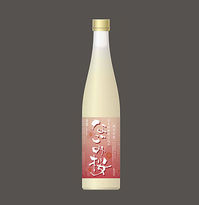 The Graduate School of Bioagricultural Sciences, Nagoya University, has conducted collaborative research since 2009 in order to produce an original sake brand together with Morita Co., Ltd. and Aichi Center for Industry and Science Technology. The sake, or rice wine, was named "Nagomi Sakura," which means "relaxing cherry blossoms" in Japanese. It features the authentic ingredients of yeast isolated from a double-flowered cherry blossom (yae-sakura) that grows on the university campus and rice for sake brewery produced every year in the university field. Since the first sake was brewed in 2012, Nagomi Sakura is so popular that it is sold out every year. Regarding succeeding its production, Associate Prof. Andres Daniel Maturana and Associate Prof. Nicolas Baumert shared their opinions about cultural interests in Japan.
The Graduate School of Bioagricultural Sciences, Nagoya University, has conducted collaborative research since 2009 in order to produce an original sake brand together with Morita Co., Ltd. and Aichi Center for Industry and Science Technology. The sake, or rice wine, was named "Nagomi Sakura," which means "relaxing cherry blossoms" in Japanese. It features the authentic ingredients of yeast isolated from a double-flowered cherry blossom (yae-sakura) that grows on the university campus and rice for sake brewery produced every year in the university field. Since the first sake was brewed in 2012, Nagomi Sakura is so popular that it is sold out every year. Regarding succeeding its production, Associate Prof. Andres Daniel Maturana and Associate Prof. Nicolas Baumert shared their opinions about cultural interests in Japan.
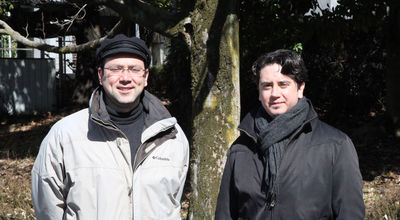 Associate Prof. Maturana (left) & Associate Prof. Baumert (right)
Associate Prof. Maturana (left) & Associate Prof. Baumert (right)
(The interview was conducted by Ayako Umemura/NU Research.)
“Nagomi Sakura is a proud gift from Nagoya University” to introduce traditional Japanese culture, and Nagoya University.
NU Research:
It is an utmost pleasure to interview you and to hear about Nagomi Sakura, the original sake brand of Nagoya University, especially from an international perspective. First, could you tell us about your major research interests?
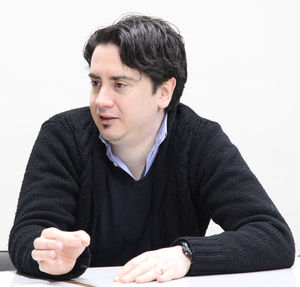 Associate Prof. Baumert:
Associate Prof. Baumert:
I am an Associate Professor at the Institute of Liberal Arts & Sciences, Nagoya University.
My subject is geography, and I completed my PhD in France with a special interest in the comparison between wine and sake and their regional cultural backgrounds. Besides the geographical idea, Japanese sake is becoming very popular around the world.
By the way, I should say “Japanese rice-wine” instead of “sake” because Japanese sake is made from rice regionally produced only in Japan and is different from other types of rice production in Asia. This is of particular interest to me as the concept is quite similar to French wine, which has been studied at a regional cultural level in terms of geography in France. In my research, by applying similar methods, I have investigated Japanese sake by comparing different types of rice wine production in all of Asia. Furthermore, I have pursued answers as to why specific regions in Japan, such as Kyoto, Hyogo, and Niigata, are famous for Japanese sake. There are two discussions emanating from the comparison between wine and sake: one refers to culture, and the other refers to the production level (i.e., process, ingredients, etc).
NU Research:
The cultural discussion is interesting, especially when it is about alcohol! Regarding Nagomi Sakura’s production level, I suppose the Graduate School of Bioagricultural Sciences could answer with some opinions.
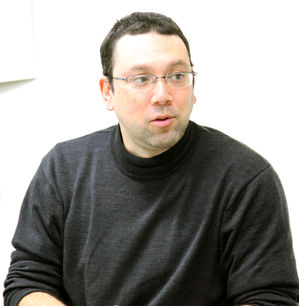 Associate Prof. Maturana:
Associate Prof. Maturana:
Nagomi Sakura was in fact produced by the microbiologist, Prof. Masashi Kato, when he was working at the Graduate School of Bioagricultural Sciences, Nagoya University. I belong to the Graduate School; however, my major research interests lie in the physiology of animal muscles to understand the physical construction of bodies and to apply this to cure diseases in medical biology, which is very different from sake production.
I am responsible for the production of Nagomi Sakura. This is because responsible people are moving out of the university. After Prof. Kato left Nagoya University, Nagomi Sakura was succeeded to Prof. Shunichi Kuroda within the Graduate School. Prof. Kuroda also left later on and because I was a member of Prof. Kuroda’s group, I am now responsible. I really enjoy it, although sake is not my research subject.
NU Research:
Faculty members of universities are moving in and out as part of their career paths; on the other hand, it is important to succeed the university’s original production. Although your research themes are very different from sake production, I guess that you are more or less a fan of sake in general.
Associate Prof. Maturana:
Indeed, I like sake. When I worked in Tokyo, I had my first experience of sake. Then, I moved to Niigata for my work where I had many sake experiences, and I was impressed with the sake culture there. People in Niigata drink a lot of sake, while shochu (i.e., distilled spirit) seems to be more popular than sake in Tokyo, Osaka, and the south of Japan; at least that is my impression. From my experience, I found that the regional culture is also interesting.
There are many different types of sake, and I am especially a fan of the dry ones. My absolute favorite is Daiginjo, which is the highest quality sake brewed from rice grains milled to 50% or less of their weight.
Associate Prof. Baumert:
You can enjoy many different varieties of sake, especially nowadays. When I conducted a survey some years ago, I found that sake was not very popular in Japan, a different trend to what was happening overseas. However, sake is becoming popular in Japan again due to the development of varieties of flavors, like cocktails with sweetness and sake similar to dry white wine with more acidity, in accordance with the changing food culture in Japan.
Maybe because of my cultural background, I prefer the dry type too. I cannot ignore the Junmai as an important measure to determine the quality and the authenticity of sake.
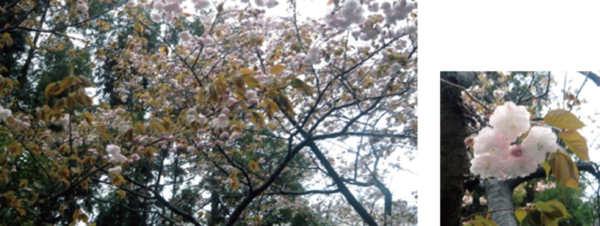 A double-flowered cherry blossom (yae-sakura) that grows on the university campus
A double-flowered cherry blossom (yae-sakura) that grows on the university campus
NU Research:
Nagomi Sakura is placed in the sweet and fruity sake category, which is especially targeted toward young people or women who are not very familiar with sake.
Associate Prof. Maturana:
To be honest, Nagomi Sakura is too sweet for me; however, I have found that current university students and young researchers in Japan are not familiar with alcohol, even beer. For those who do not like bitter or dry alcohol, Nagomi Sakura is a good choice.
Associate Prof. Baumert:
Nagomi Sakura is, I find, like French sweet dessert wine. If you are more familiar with ume-shu (i.e., plum wine), Nagomi Sakura can be a replacement for it. It is nice to have before eating food or after the meal with fruits or ice-cream.
NU Research:
In order to succeed and develop the Japanese traditional culture of sake, what do you think is important for the younger generation?
Associate Prof. Maturana:
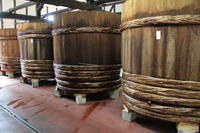 I think students need to experience the procedure of sake preparation in order to get more interested.
I think students need to experience the procedure of sake preparation in order to get more interested.
In fact, when I visited Morita Co., Ltd. with students for the brewing of Nagomi Sakura, I was impressed and excited with the brewery, which is one of the oldest in Japan. Morita Co., Ltd. also brews miso and other traditional Japanese products, and the extent of their knowledge is admirable.
Regarding Nagomi Sakura’s production line, its preparation is not limited to within the university. The rice grown in the university field is brought to Aichi Center for Industry and Science Technology for polishing, and then brewed at Morita Co., Ltd. This is a product produced through a collaboration, and it is worth learning about the process for the implementation of research, especially for students.
 Brewing scenes of Nagomi Sakura at Morita Co., Ltd.
Brewing scenes of Nagomi Sakura at Morita Co., Ltd.
Associate Prof. Baumert:
Throughout Nagomi Sakura’s production line, students at Nagoya University can have authentic experiences. Unfortunately, I have missed opportunities to visit Morita Co., Ltd. However, as long as I am at Nagoya University, I look forward to having a genuine brewing experience.
You know, I bring Nagomi Sakura as a proud gift from Nagoya University whenever I visit laboratories all over the world; it is a production of traditional Japanese culture. Moreover, it is the original brand of Nagoya University.
NU Research:
Thank you very much for your opinions! Nagomi Sakura can provide us with many opportunities to have authentic experiences through collaborative work with the brewery and the research center, while also introducing Japanese culture and Nagoya University.
Interested in tasting?
Nagomi Sakura is sold limitedly with only 1,000 bottles every year. Do not miss the chance to grab one this year!
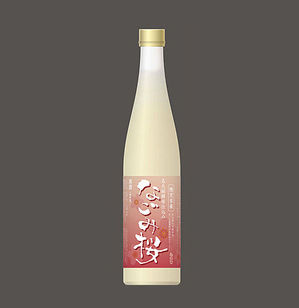 Profile of Nagomi Sakura
Profile of Nagomi Sakura
- Product name: Nagomi Sakura
- Volume・Container: 500 ml・Glass bottle
- Price: \1,234 (incl. tax)
- Sale date: in March
- Availability: 1,000 bottles
- Manufacturer: Morita Co., Ltd.
- Seller: Nagoya University Coop (Furo-cho, Chikusa-ku, Nagoya-shi)
- Place to buy: North-branch, Nagoya University Coop
EMAIL nagomizakura@coop.nagoya-u.ac.jp
TEL +81(0)52 782 1110)
Quality information
- Nihonshu-do (sake meter value): −54
- San-do (acidity): 4.0
- Amino san-do (amino acid value): 2.9
- Alcohol content: 12%−13%
Links



 Associate Prof. Maturana (left) & Associate Prof. Baumert (right)
Associate Prof. Maturana (left) & Associate Prof. Baumert (right) Associate Prof. Baumert:
Associate Prof. Baumert: Associate Prof. Maturana:
Associate Prof. Maturana: A double-flowered cherry blossom (yae-sakura) that grows on the university campus
A double-flowered cherry blossom (yae-sakura) that grows on the university campus I think students need to experience the procedure of sake preparation in order to get more interested.
I think students need to experience the procedure of sake preparation in order to get more interested.
